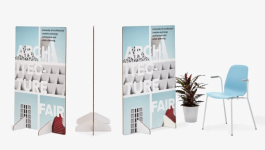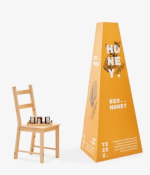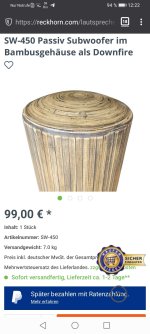It's really easy to do. For the openings for the drivers I take silicone and make a rope around the opening. So no cement leaks out. Take a spoon to fill one side and wiggle the box in order to spread the cement equally everywhere.
The screws put in advance into the wood and even with thin wood the screws have already the right depth.
The screws put in advance into the wood and even with thin wood the screws have already the right depth.
So, not having read every page of this thread, I may just be the person in the very unique position to build a good enclosure from cardboard. I came across this thread after thinking about it while looking at the materials I have at my disposal combined with tools, equipment, skills and training in fabrication.
Hear me out: I have literally thousands of 48"x96" double wall (skin/corrugated/skin/corrugated/skin construction) 275lb sheets of new cardboard. I have hundreds of ft/sq of various light weight fiberglass and exotic cloths, appropriate resins. Cnc panel saw for cutting.
I am thinking of trying 3 layers of 6mm double wall corrugated, a 0.75oz/yd/sq non-directional strand mat cloth for laminating between layers and filling the corrugations with a fine sand, maybe just the middle lamination, and trying it out.
My issue is I do not have the test equipment to properly validate/qualify the material and construction of the box sonically.
Before I go spending the time and effort building a small speaker box from cardboard/FRG and another one from MDF to swap drivers back and forth for testing, does my thinking sound out of line?
Hear me out: I have literally thousands of 48"x96" double wall (skin/corrugated/skin/corrugated/skin construction) 275lb sheets of new cardboard. I have hundreds of ft/sq of various light weight fiberglass and exotic cloths, appropriate resins. Cnc panel saw for cutting.
I am thinking of trying 3 layers of 6mm double wall corrugated, a 0.75oz/yd/sq non-directional strand mat cloth for laminating between layers and filling the corrugations with a fine sand, maybe just the middle lamination, and trying it out.
My issue is I do not have the test equipment to properly validate/qualify the material and construction of the box sonically.
Before I go spending the time and effort building a small speaker box from cardboard/FRG and another one from MDF to swap drivers back and forth for testing, does my thinking sound out of line?
Just a suggestion on testing/listening: don't swap drivers, just do one of each and listen to a stereo track twice with preamp cable L/R (quickly) swapped in between play. I used this trick to choose 1st-order series XO over parallel; the series-XO speaker half-soundstage was always preferred. But for your application size really matters. Small-scale result isn't indicative of (relatively) thin large panels, possibly reinforced with multi-line internal bracing.
Sounds interesting to me. Exotic materials are not bad.
Commercial PA systems often use thin polypropylene boxes and they work fine with low weight.
I used cardboard for closing one side of a wooden box because I can cut it with a scissor. Later I reinforced it with alu foil and concrete.
However on CNC you can work with any material in the most sophisticated way.
Commercial PA systems often use thin polypropylene boxes and they work fine with low weight.
I used cardboard for closing one side of a wooden box because I can cut it with a scissor. Later I reinforced it with alu foil and concrete.
However on CNC you can work with any material in the most sophisticated way.
It would be interesting measuring the differences between filling the corrugations with sand, filling them with "green glue" (if it's possible to get it into them, I've never used the stuff), or leave them empty, as an air gap. On my current build, I'm thinking of covering 6 mm MDF with 1/8 PLY, but I'm wondering if I should use PVA, something like green glue, or green glue foam, or leave an air gap, using small strips of foam to maintain a gap (to stop rattles ).filling the corrugations
The conclusion of this thread so far are that cardboard is not good for speaker fabrication: large panels are not stiff enough and becomes a passive radiator, and it is difficult to attach a heawy/big driver without crushing or deforming the cardboard panel. If you find a way to overcome those major limitations, then I'm very interested on the results. I guess that the stiffness issue cannot be solved completely; but it does not need to be (within limits), as countless speakers with thin plastic enclosoure have shown. A way to securely attach the driver to the cardboard panel may be more difficult to devise. Glue is a solution, but it is messy and some load-bearing support is still required for large drivers.Before I go spending the time and effort building a small speaker box from cardboard/FRG and another one from MDF to swap drivers back and forth for testing, does my thinking sound out of line?
I have experienced both shortcomings myself in the past and they were a showstopper, but I've recently looked again at this material, and things have changed. Standard cardboard furniture made with durable double-wall or high-thickness internal honeycomb is now available at low price from any online digital printing service for the advertising market. The cardboard does have a custom scratch-proof digital print at one or both sides and there is no minimum order quantity. As example, a 10mm honeycomb-reinforced panel with feets, 95cm width (approx. 3ft) by 135cm height (approx 4,5 ft), printed on both sides with any picture you want (just supply the pdf file), will cost less than 50 euro shipped. Folded shapes such as totems with square or triangle base up to 2m in height are also available. The custom print is a significant advantage, because the speakers may become room decoration instead of ugly technical items. The honeycomb reinforced cardboard is the exact same material used as core on most cheap furniture such as Ikea "Lack" shelves and tables. I wonder if a panel of thin synthetic glass may be enough to dampen the vibration of the panel, doubling up as protection for the picture on the honeycomb-core cardboard panel. A wooden planck may be required on the back, but the structure must remain cheap and easy to assemble, otherwise it would be best to start with a more suitable material on the first place. I'm not very keen on sand filling for this reason. It seems messy.
Attachments
Last edited:
For attaching drivers, since I was thinking of using fiberglass between layers of and on the outside of the panels, I would simply over drill and pot the holes with epoxy, or simply insert a wood disc in the appropriate location that would be glassed in. Basic construction techniques for foam/balsa core laminates. One of my race boats is CF with 1/2" thick foam in the middle. Hardware attachments are drilled 2x larger than fasteners, filled with epoxy and then drilled for fasteners. Creating a solid column of epoxy between layers for support.
I've seen solid cardboard tubes commonly used as forms for cylindrical concrete pillars put to use in subwoofers. Round top & bottom pieces are used to complete the enclosure. Woofer driver is mounted in the bottom circular piece, which has a cutout for it. The tubes are very sturdy, about 1/2 inch thick, and they work so well because there are no flat side walls to flex with the bass notes. The cardboard is under tension in that kind of a setting, and it does not stretch much at all, resulting in a very dimensionally stable enclosure.With the Wharfedale IVs firmly in place in my listening area, I got to thinking, could a cardboard cabinet with one of the low cost speakers I have lying around approach the sound quality of that commercial unit? Used speakers are a huge hargain, however I was interested enough to start experimenting.
You Tube videos of cardboard speakers tend to demonstrate that these speakers sound a little boxy, in my opinion. The configuration is pure boombox in many instances, and not the bookshelf look that I wanted.
I attempt to answer the following questions:
1. How good will a corrugated cardboard speaker enclosure sound?
2. Will the bass produced be adequate, in a sealed box and with a port?
3. Will I be able to achieve a decent finish (I intend to cover it with vinyl sticker)
4. Will the speakers be durable in everyday use over the long term?
5. Will the resonance from the enclosure swamp the mid frequencies and make the loudspeaker unlistenable to?
I intend to use software equalizer for all listening, but as minimal as possible.
Initial testing with a crude enclosure was promising, with improved sounds, but this was not a sealed box.
On the importance of a good seal : this is to dampen the speaker resonances and move down the frequency response peak? Is that correct?
I have already cut the sides and glued double layers of cardboard together. The speaker driver in question is working fine in an open baffle with a little bass boost.
Sonotubes are different, being solid cardstock and wound/glued into a homogenous product. I'm considering using corrugated cardboard, but with some serious stiffening and laminating different layers. Maybe I'll start with some basic single panel testing using an accelerometer or a DML speaker panel to test.
I've got a bunch of traveling coming up in the next two months, so it may be closer to the holidays before I get to actual testing of this.
I've got a bunch of traveling coming up in the next two months, so it may be closer to the holidays before I get to actual testing of this.
I thought of using the tube like this. I had this idea many years ago, the dispersion cone, but since patented.
Cardboard tubes would be excellent for this, simplicity, strength, and possibly WAF. It will need a cloth cover on top.

Cardboard tubes would be excellent for this, simplicity, strength, and possibly WAF. It will need a cloth cover on top.
Commercially in Germany Mr Reck from reckhorn dot Com offered a low cost subwoofer with cardboard enclosure.
Now he uses bamboo. Often people were complaining about paper as the cheap material.
https://reckhorn.com/lautsprecher/s...ubwoofer-im-bambusgehaeuse-als-downfire?c=125
Now he uses bamboo. Often people were complaining about paper as the cheap material.
https://reckhorn.com/lautsprecher/s...ubwoofer-im-bambusgehaeuse-als-downfire?c=125
Attachments
I had built my first Karlsonator out of cardboard with Faital 3FE25. It's sound was great although nothing below 70hz.Tapered line and folded horns are beyond me at this stage, though someone once suggested I build a Karlsonater. Maybe a cardboardsonater is in the future, but lets see.
The secret of cardboard as a cabinet material is using PVA wood glue to stiffen it and using 2 layers one vertically and one horizontally glued together with pva glue.
After the two layers are glued together the two sides need to be covered with PVA glue as well . It can be applied with a roller for a more even layer.
To make it more dead the sinusoidal cavities can be filled with very fine sand. Once filled to the top, thinned down PVA glue will nicely be soaked in and stiffen the corners pretty strong.
It is best to start with the speaker hole and fill the open cavities half an inch deep with tightly rolled cotton balls or little paper towel rolls and led insant glue be soaked in. This will hold up to the screws quite well.
An encloser done this way will cost very little but can compete with most any material.
For a finish I suggest to roll on another PVA layer and sprinkle fine sand on.
I did this to my Ripoles.
cardboard used for the back side of the box.
later I put aluminium foil inside to prevent making the paper wet and reinforced all box sides internally with 1cm concrete.
Box was a design all purpose tool box. Five wooden sides already there so easy work for diy project.
Always wanted to try my 8cm diy aluminium sandwich foiled fullranges in a bigger box.
Reflex tuned low to 30hertz.



diy alu tweak
https://www.diyaudio.com/community/...loudspeaker-sandwich-cone.402917/post-7443470
small 8cm jvc fullrange opened, kapton former, faraday pole piece
later I put aluminium foil inside to prevent making the paper wet and reinforced all box sides internally with 1cm concrete.
Box was a design all purpose tool box. Five wooden sides already there so easy work for diy project.
Always wanted to try my 8cm diy aluminium sandwich foiled fullranges in a bigger box.
Reflex tuned low to 30hertz.
diy alu tweak
https://www.diyaudio.com/community/...loudspeaker-sandwich-cone.402917/post-7443470
small 8cm jvc fullrange opened, kapton former, faraday pole piece
Sound test. Sounds really good. If close to back wall also good bass.
Slight EQ for listening (measurements without EQ!)
+5db at 60 hertz
-3.5db at 150 hertz
+3.5db at 14 khz
measured in this position


8cm driver goes down to 120hertz
with reflex down to 100 hertz and falling response down to 50hertz (measured back side at the reflex port)

this is a true high end loudspeaker for voices and with moderate listening level
at all frequencies sounding right, also in the bass.
measurements roughly made with white noise and spectroid as measurement program (all smartfone based)
Slight EQ for listening (measurements without EQ!)
+5db at 60 hertz
-3.5db at 150 hertz
+3.5db at 14 khz
measured in this position
8cm driver goes down to 120hertz
with reflex down to 100 hertz and falling response down to 50hertz (measured back side at the reflex port)
this is a true high end loudspeaker for voices and with moderate listening level
at all frequencies sounding right, also in the bass.
measurements roughly made with white noise and spectroid as measurement program (all smartfone based)
If I remember correctly, this thread was started because the op wanted to make speakers without sawing wood, I have made some speakers out of 3.4 mm ply, and I have cut thicker ply with a Stanley knife - though I wouldn't say it was easy.
I am always looking for an easy way to make loudspeaker boxes.
Carboard boxes could be lined with plastic inside and used as a form for a concrete box.
Was also thinking about a cardboard box with several layers bonded with silicone together.
Carboard boxes could be lined with plastic inside and used as a form for a concrete box.
Was also thinking about a cardboard box with several layers bonded with silicone together.
from a stability point structured craft paper can be very stable but some damping should be added like car bitumen pads.

That honeycomb cardboard looks interesting, if it was skinned on both sides with balsa wood, or very thin ply, it could make a very rigid but light enclosure; much like the Celestion SL600.
- Home
- Loudspeakers
- Planars & Exotics
- Are cardboard enclosures any good?


